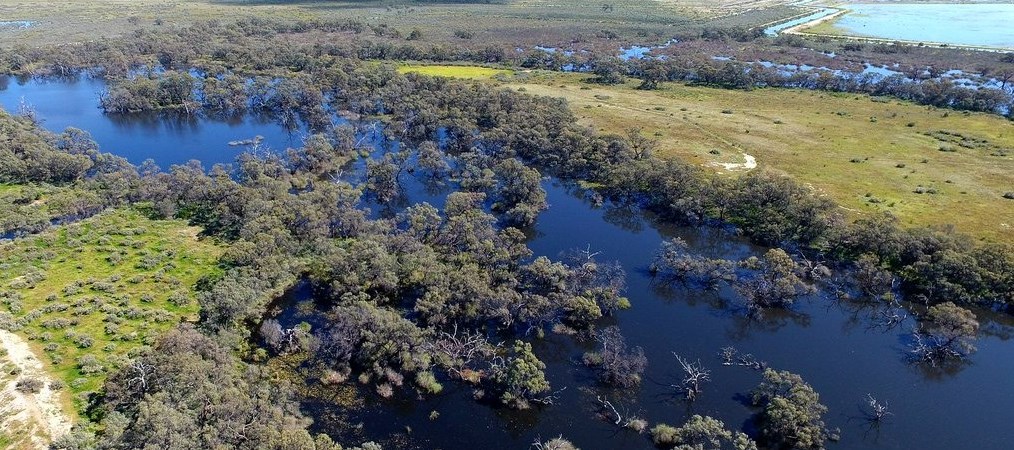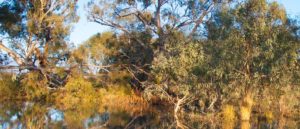The Murray-Darling Basin is one of the world’s largest and most productive river basins, accounting for $19 billion of agricultural output and providing one third of Australia’s food supply.
The Murray–Darling Basin is the largest and most complex river system in Australia. It runs from Queensland, through New South Wales and the Australian Capital Territory, Victoria and South Australia, spanning 77,000 kilometers of rivers, many of which are connected.
It harbors some of our most important natural assets, supporting a diverse array of animals, plants and ecosystems of national and international significance. This includes 35 endangered birds and 16 endangered mammals.
However, the Murray-Darling is also one of the most vulnerable river basins on Earth. Decades of poorly-designed civil engineering, over-allocation or water to agriculture and cities, along with the drying effect of climate change have significantly reduced runoff to rivers, creeks and wetlands within the basin.
In a recent assessment of overall ecosystem health, more than 80 percent of the Murray-Darling Basin’s river valleys were rated as being in poor or very poor health based on assessments of fish, invertebrates and vegetation. The Basin’s ecosystems are suffering and as a result, many species that depend on the region’s natural flooding cycle face extinction.
To address these environmental concerns, The Nature Conservancy (TNC) established the Murray-Darling Basin Balanced Water Fund to provide water security for farmers, while protecting and restoring culturally significant wetlands that support threatened species and ecosystems.
The Fund invests in permanent water rights in the Southern Murray-Darling Basin and allocates those rights in a smart way. When water is abundant and agricultural demand is lower, more water will be made available to local wetlands. When water is scarce and agricultural demand is higher, more water will be made available to irrigation.
This approach optimizes agricultural and environmental outcomes by replicating the natural wetting and drying cycles of the Basin. It’s a win-win approach, aligning the interests of people and nature.
The Fund is a partnership among The Nature Conservancy, the Murray Darling Wetlands Working Group and Kilter Rural. The Fund provides the following conservation outcomes:
- Improved waterbird and native fish habitats including breeding habitats;
- Improved health for wetlands, floodplain forests and woodlands;
- Sustainability of plant and fish refuges; and
- Increased wetland plant health and growth.
In addition to environmental outcomes, the restoration of environmental flows will help to conserve sites of important Aboriginal cultural and spiritual value.
Progress is being made on many fronts. In May of 2018, it was announced that a giant floodplain in the Riverina district of New South Wales (NSW)—long a stark illustration of wetland mismanagement—could soon become a shining example of environmental restoration.
The NSW Government announced a new partnership for a ambitious restoration project. The area involves 11 farms purchased in largest water buyback of Murray-Darling Basin plan. Conservation, Aboriginal and scientific groups are working with The Nature Conservancy as the managers of the Nimmie-Caira project. It’s arguably the most ambitious environmental restoration project to emerge from the Murray-Darling Basin Plan
Now, in September of 2018, Australian business leader John B. Fairfax made a $2 million gift to TNC in support of the Gayini Nimmie-Caira Project, the most ambitious restoration and conservation project ever undertaken in the Murray-Darling Basin. The gift also establishes the John B. Fairfax Conservation Fellowship.
Mr Fairfax’s gift will fund the operational costs of Gayini Nimmie-Caira over a two-year period including the creation of the fellowship. Fairfax said “I was inspired by the ambitious vision for the property, including enhanced Aboriginal cultural heritage, sustainable agriculture and the conservation of world-class waterbird breeding habitat”. He says that he hoped his commitment to fund the operating costs of the project will inspire others to donate to revitalizing both conservation and culture.
The inaugural John B. Fairfax Fellow is Indigenous leader Rene Woods of the Nari Nari First Nation. Woods is the Chair of Murray Lower Darling Rivers Indigenous Nations, and was recently appointed as the Gayini Nimmie-Caira Project Manager.
“I am looking forward to working with TNC as the Gayini Nimmie-Caira Project Manager, helping to provide opportunities for the Hay and Balranald communities to reconnect with Country”, said Mr Woods. “I’m thrilled to receive the fellowship. Being a traditional custodian of the Country, I’m honoured to manage, protect and enhance Country. I thank John B. Fairfax for the opportunity to further develop my conservation and leadership skills during the fellowship” he added.
Gayini Nimmie-Caira is 85,000 hectares of internationally significant Murrumbidgee floodplain in south-west NSW. In May, the NSW Government announced it had appointed a consortium, comprising TNC, the Nari Nari Tribal Council, the Murray Darling Wetlands Working Group and the Centre for Ecosystem Science at UNSW Sydney to manage the property .
The project is a once-in-a-generation opportunity to create a new, sustainably managed and financed conservation property for the benefit of people and nature. This creates a ground-breaking win for nature, the local economy and Indigenous re-connection to Country. The project is supported by the NSW and Commonwealth governments.
The Nature Conservancy-led consortium is delighted to be able to implement its innovative plan for the future management of Nimmie-Caira, the largest remaining area of wetlands in the Murrumbidgee Valley. This represents a significant project in efforts to restore one of the more important wetlands in the Murray-Darling Basin.
Featured photo ©James Fitzsimons, courtesy of TNC.
Learn more about the Nimmie-Caira consortium.
See May 2018 ABC news article.


